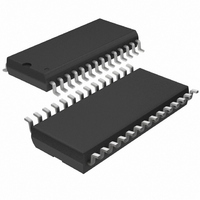LTC1410ISW Linear Technology, LTC1410ISW Datasheet - Page 9

LTC1410ISW
Manufacturer Part Number
LTC1410ISW
Description
IC A/D CONV 12BIT SAMPLNG 28SOIC
Manufacturer
Linear Technology
Datasheet
1.LTC1410CSWPBF.pdf
(16 pages)
Specifications of LTC1410ISW
Number Of Bits
12
Sampling Rate (per Second)
1.25M
Data Interface
Parallel
Number Of Converters
1
Power Dissipation (max)
230mW
Voltage Supply Source
Dual ±
Operating Temperature
-40°C ~ 85°C
Mounting Type
Surface Mount
Package / Case
28-SOIC (0.300", 7.50mm Width)
Lead Free Status / RoHS Status
Contains lead / RoHS non-compliant
Other names
LTC1410IS
Available stocks
Company
Part Number
Manufacturer
Quantity
Price
Part Number:
LTC1410ISW
Manufacturer:
LINEAR/凌特
Quantity:
20 000
APPLICATIONS
Intermodulation Distortion (IMD)
If the ADC input signal consists of more than one spectral
component, the ADC transfer function nonlinearity can
produce Intermodulation Distortion in addition to THD.
IMD is the change in one sinusoidal input caused by the
presence of another sinusoidal input at a different
frequency.
If two pure sine waves of frequencies f
to the ADC input, nonlinearities in the ADC transfer func-
tion can create distortion products at the sum and differ-
ence frequencies of mf
etc. For example, the 2nd order IMD terms include
(f
the value (in decibels) of the 2nd order IMD products can
be expressed by the following formula:
where V
quency and V
second through nth harmonics. THD vs Input Frequency is
shown in Figure 4. The LTC1410 has good distortion
performance up to the Nyquist frequency and beyond.
a
+ f
IMD f
b
). If the two input sine waves are equal in magnitude,
1
a
is the RMS amplitude of the fundamental fre-
–100
–10
–20
–30
–40
–50
–60
–70
–80
–90
Figure 4. Distortion vs Input Frequency
f
0
b
1k
2
through V
20 log
U
10k
INPUT FREQUENCY (Hz)
a
Amplitude at f
INFORMATION
2ND
nf
U
n
Amplitude at
100k
b
, where m and n = 0, 1, 2, 3,
are the amplitudes of the
3RD
W
1M
a
THD
and f
a
1410 G03
f
a
10M
b
f
b
are applied
U
Peak Harmonic or Spurious Noise
The peak harmonic or spurious noise is the largest spec-
tral component excluding the input signal and DC. This
value is expressed in decibel relative to the RMS value of
a full-scale input signal.
Full Power and Full Linear Bandwidth
The full power bandwidth is that input frequency at which
the amplitude of the reconstructed fundamental is re-
duced by 3dB for a full-scale input signal.
The full linear bandwidth is the input frequency at which
the S/(N + D) has dropped to 68dB (11 effective bits). The
LTC1410 has been designed to optimize input bandwidth,
allowing the ADC to undersample input signals with fre-
quencies above the converter’s Nyquist frequency. The
noise floor stays very low at high frequencies; S/(N + D)
does not become dominated by distortion until frequen-
cies far beyond Nyquist.
Driving the Analog Input
The differential analog inputs of the LTC1410 are easy to
drive. The inputs may be driven differentially or as a
single-ended input (i.e., the – A
+ A
Any unwanted signal that is common mode to both
inputs will be reduced by the common mode rejection of
the sample-and-hold circuit. The inputs draw only one
small current spike while charging the sample-and-hold
–100
–120
–20
–40
–60
–80
IN
0
and – A
0
(f
b
–f
(2f
a
)
a
–f
(f
b
a
)
)
100
IN
Figure 5. Intermodulation Distortion Plot
(f
(2f
inputs are sampled at the same instant.
b
)
b
–f
(2f
a
)
a
)
200
(f
a
+f
(2f
FREQUENCY (MHz)
b
) (2f
b
)
(3f
a
a
)
+f
300
b
(f
)
a
IN
+2f
(3f
b
input is grounded). The
)
b
)
400
f
f
f
LTC1410
SAMPLE
IN1
IN2
= 88.19580078kHz
= 111.9995117kHz
500
= 1.25MHz
600
1410 F05
9














